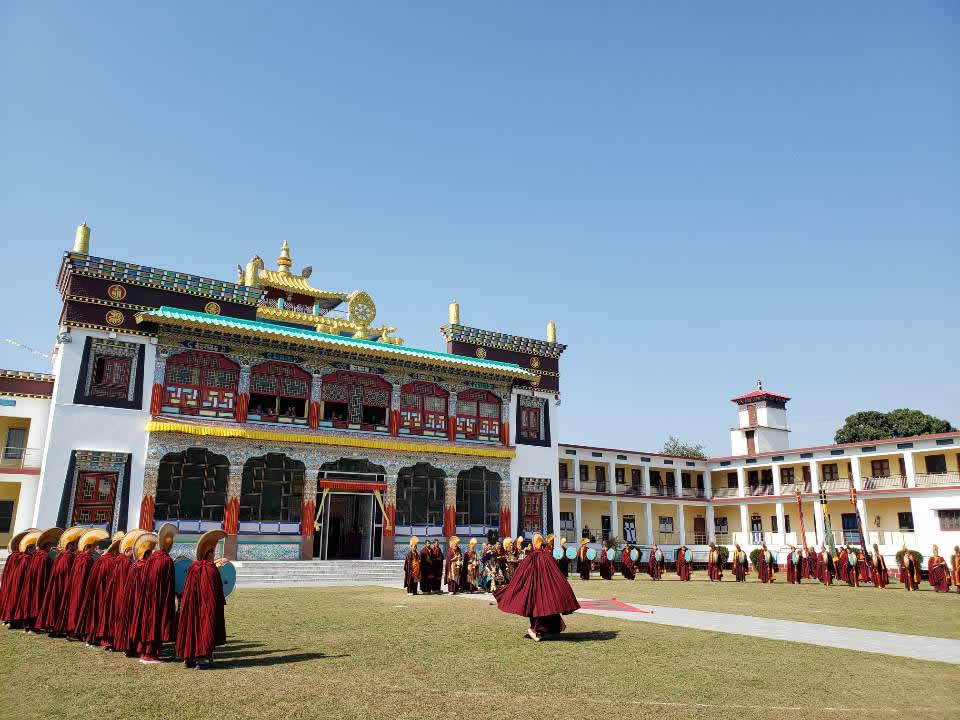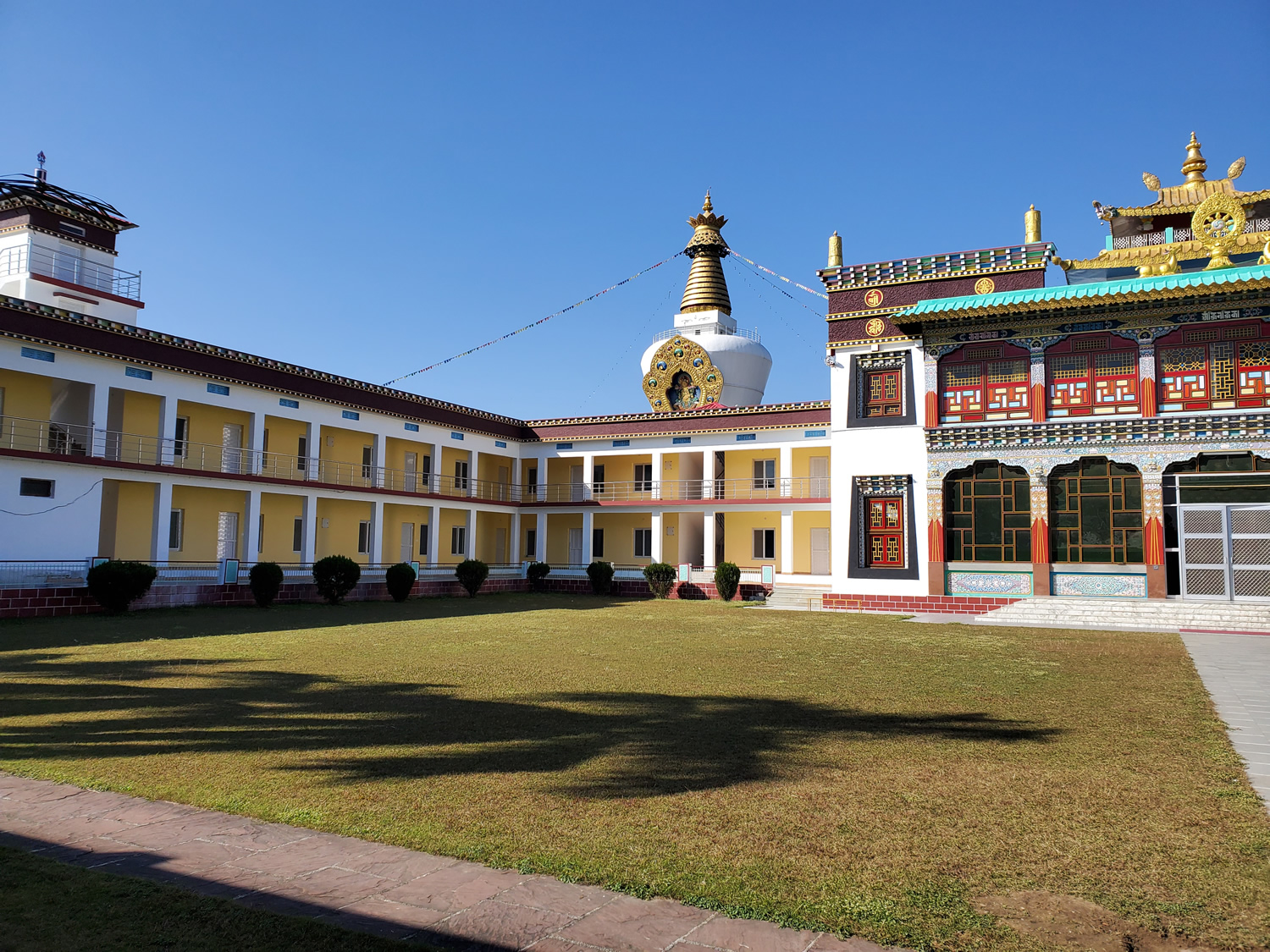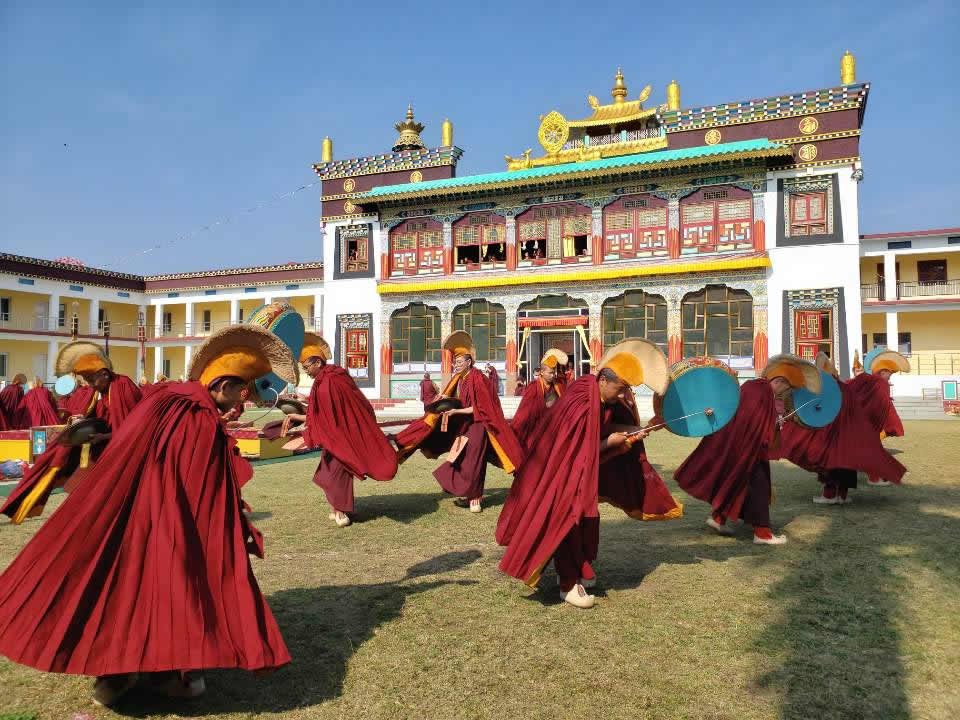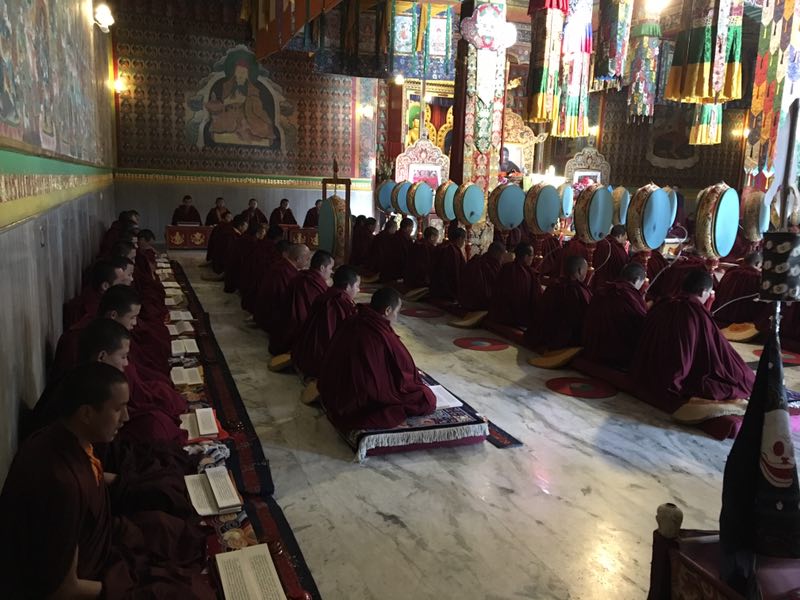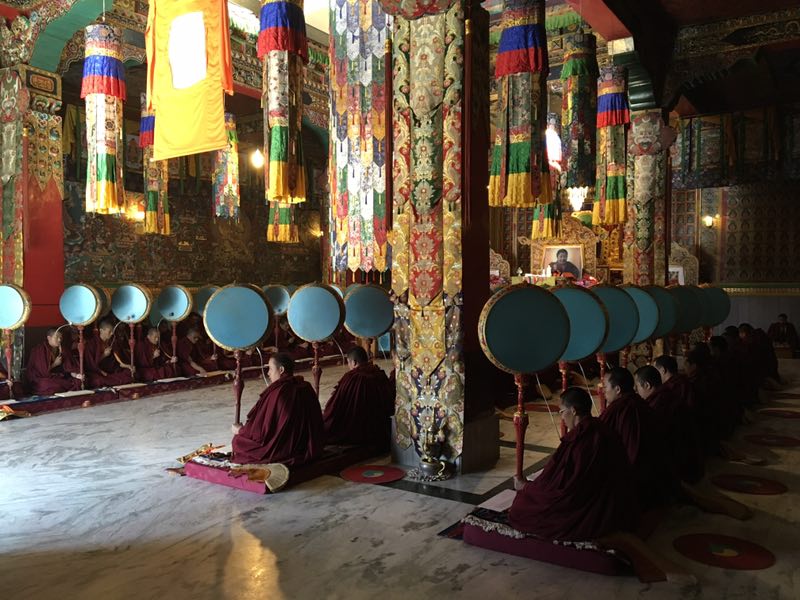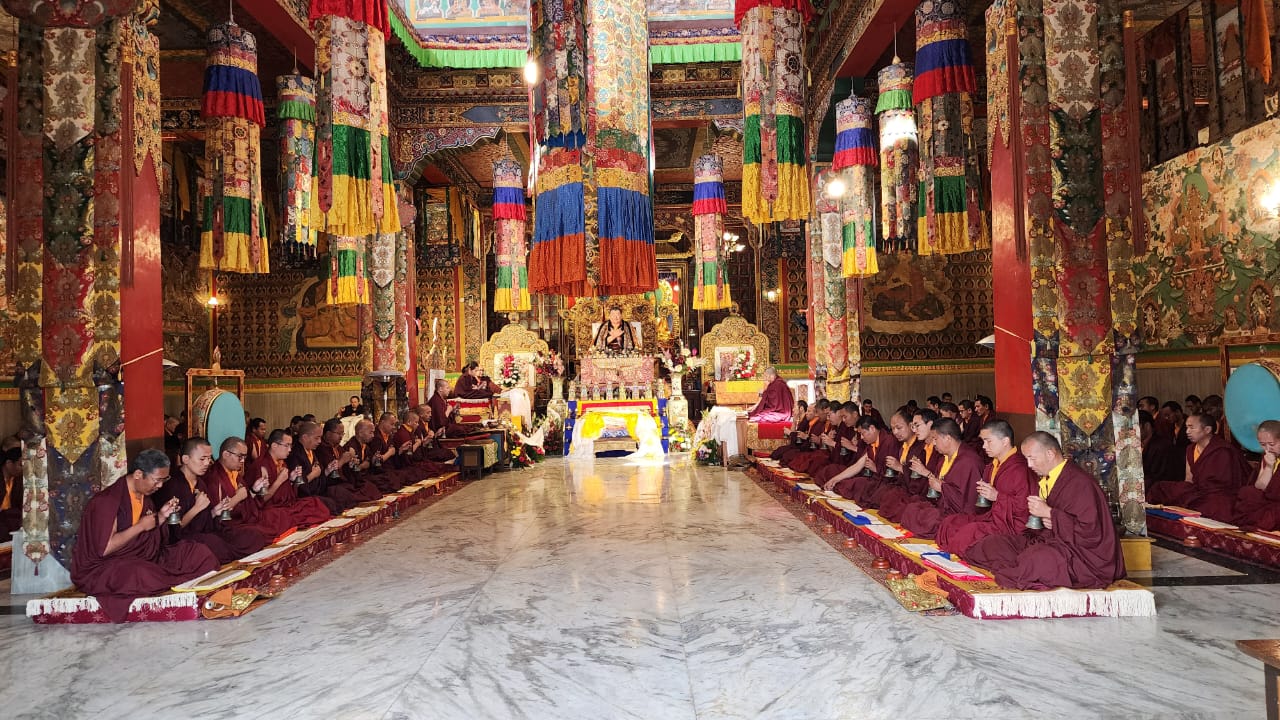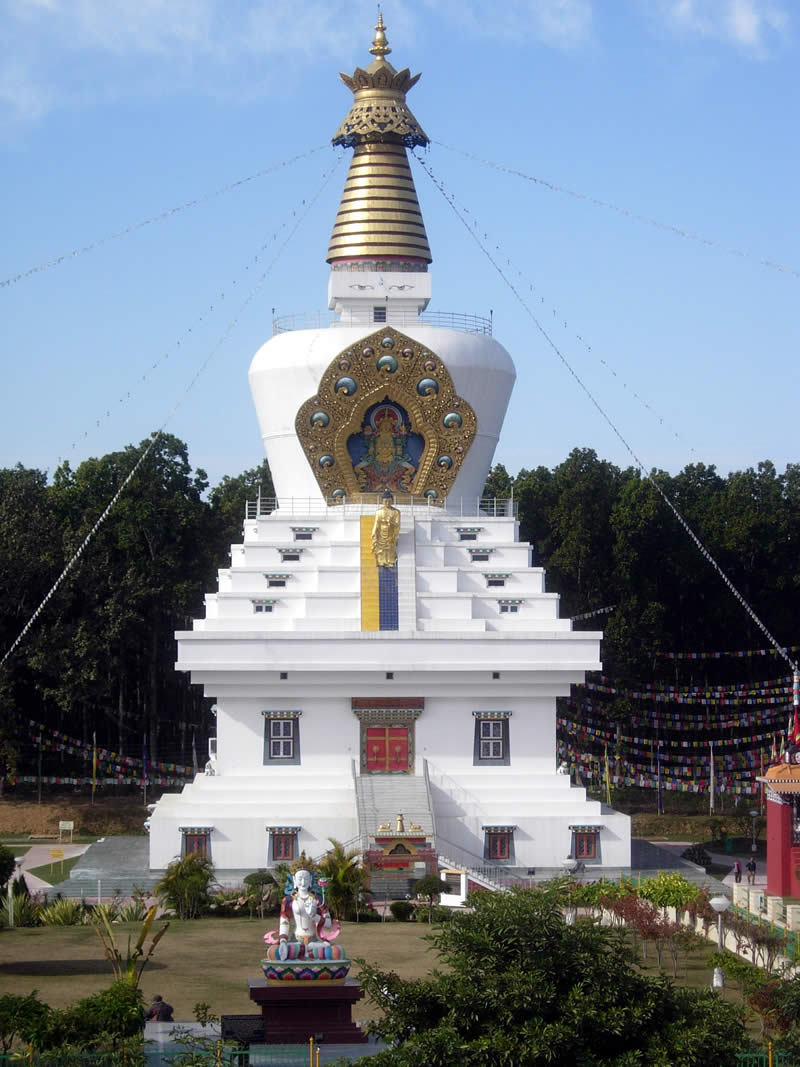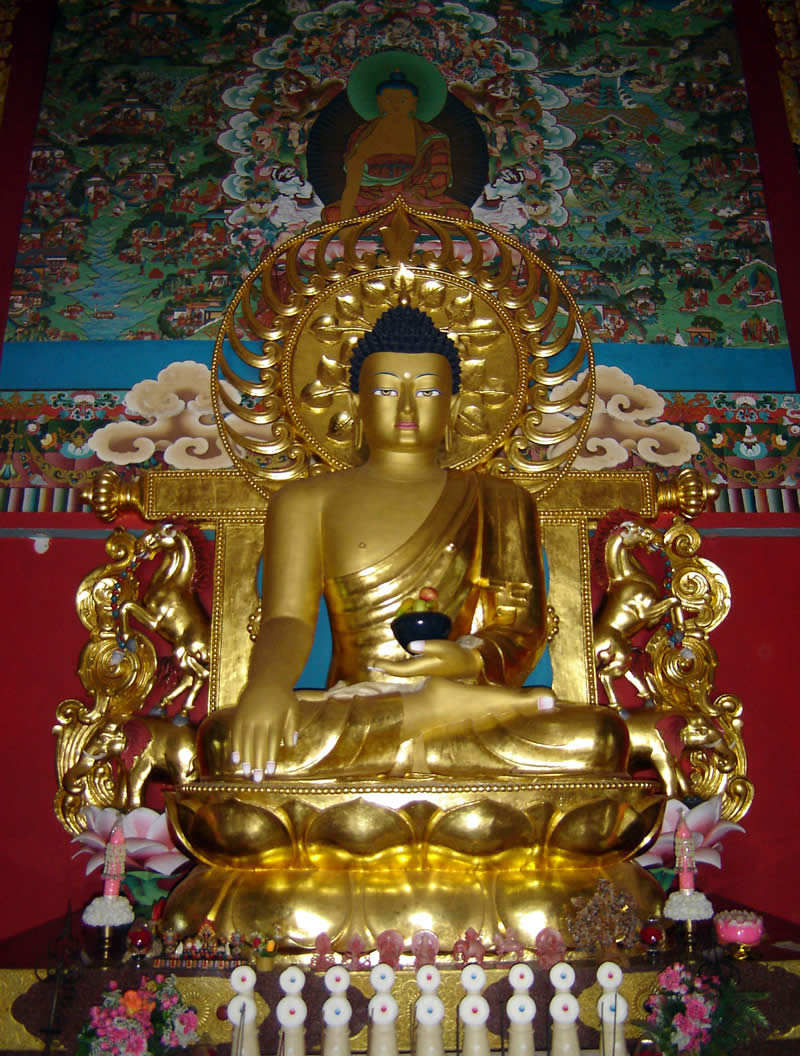Ngedon Gatsal Ling
Ngedon Gatsal Ling is the main monastery and practice center. The daily prayers as well as the Drubchens (Mahasadhanas) are performed here in the monastery’s magnificent shrine room. Monks learn and practice rituals, mandala drawing, lama dances and the playing of ritual instruments. Monks can also choose to study thangka painting and sculpting.
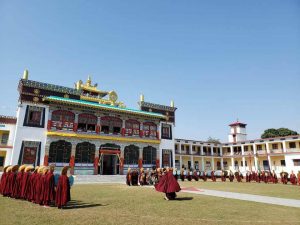
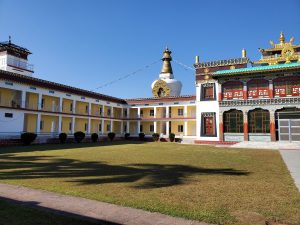
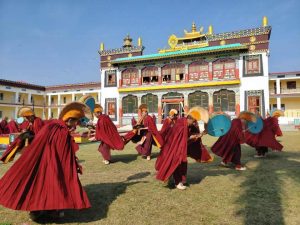
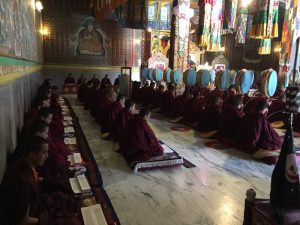
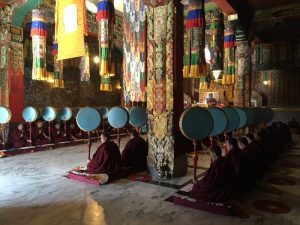
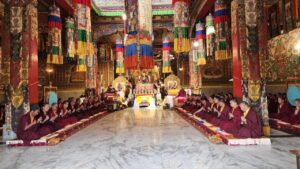
Ngagyur Nyingma College
Advanced Buddhist studies are essential to preserve the living lineage and spread the Dharma for the benefit of all beings by deepening the understanding of interdependence and the cultivation of virtue. To uphold this tradition, Ngagyur Nyingma College was founded and has grown into one of the largest Buddhist institutes, where monks study and practice according to the lineage of great masters.
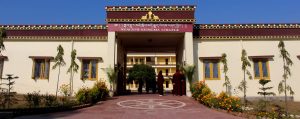
More Information about Ngagyur Nyingma College can be found here.
Padmasambhava Statue
The great statue of Guru Padmasmabhava, in the form known as Guru Dregpa Kündül (Guru Tamer of all Haughty Spirits), was formally consecrated by Kyabje Sakya Trizin on the auspicious fifth day of the first Lunar month, the 3rd of March 2017. This great statue of Guru Rinpoche was built with the sponsorship of Ugyen Dorje la.
Many years ago, Kyabje Mindrolling Trichen had instructed the members of the Tibetan community that it would be extremely beneficial to have such a statue erected in order to dispel obstacles of warfare and disharmony.
It was indeed a most joyous and auspicious occasion for Mindrolling and members of the Dhondupling Tibetan community to see this wonderful statue of the great Guru finally completed and installed at Mindrolling Monastery in accordance Kyabje Mindrolling Trichen’s vision and command.
Kyabje Sakya Trizin blessed and consecrated the great statue, and in conjunction with the auspicious occasion, bestowed the precious Thangtong Gyalpo’s Tshewang Logyama — the long life empowerment of Thangtong Gyalpo — to over five thousand people, who gathered at Mindrolling for this momentous celebration.
SEE ALSO: [ Guru Padmasambhava Statue Consecration | Mindrolling Monastery News | 4 March 2017 ]
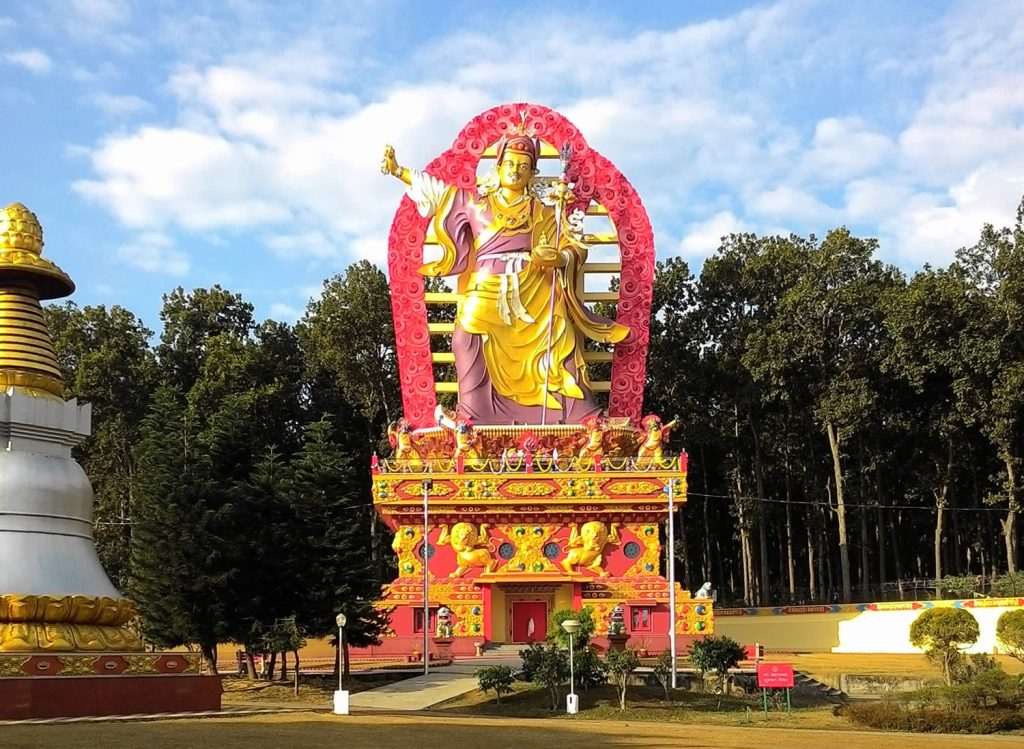
The Great Peace Stupa
The Great Peace Stupa in Og Min Ogyen Mindrolling Monastery in Dehradun, India, is 185 feet tall and 100 square feet in width. It is the world’s largest stupa and is a magnificent example of buddhist art and architecture. The stupa is surrounded by a two-acre landscaped garden.
On the facade of the stupa, Maitreya, the future Buddha, has been beautifully painted. Descending the steps is the present Buddha, the Buddha Shakyamuni.
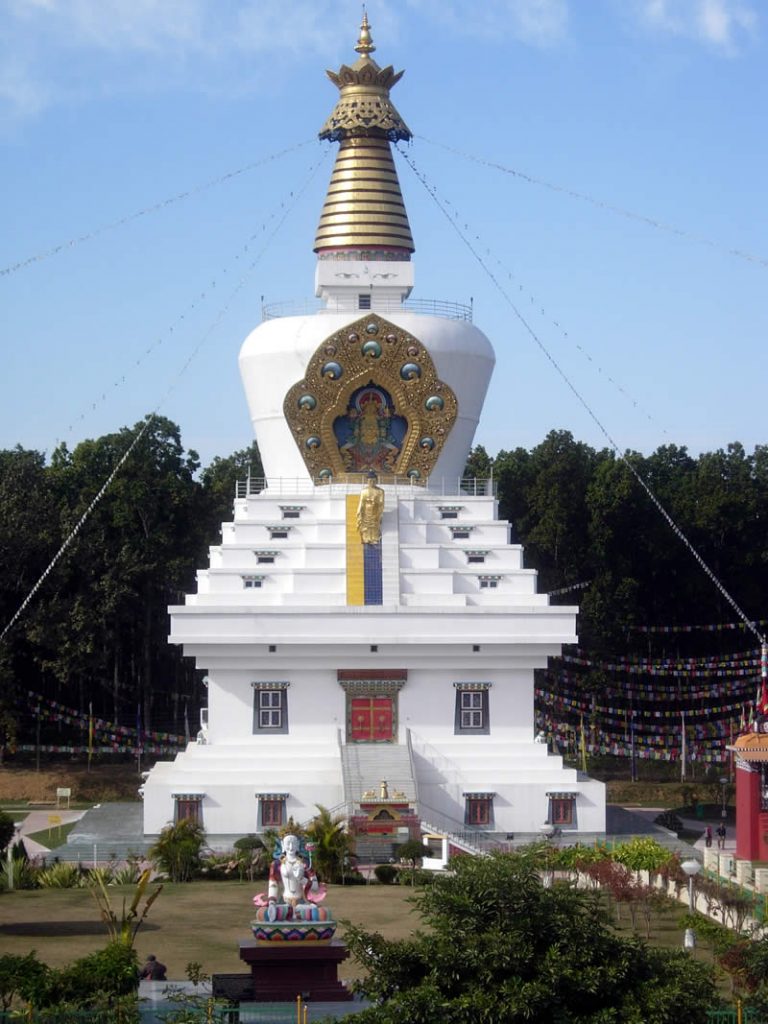
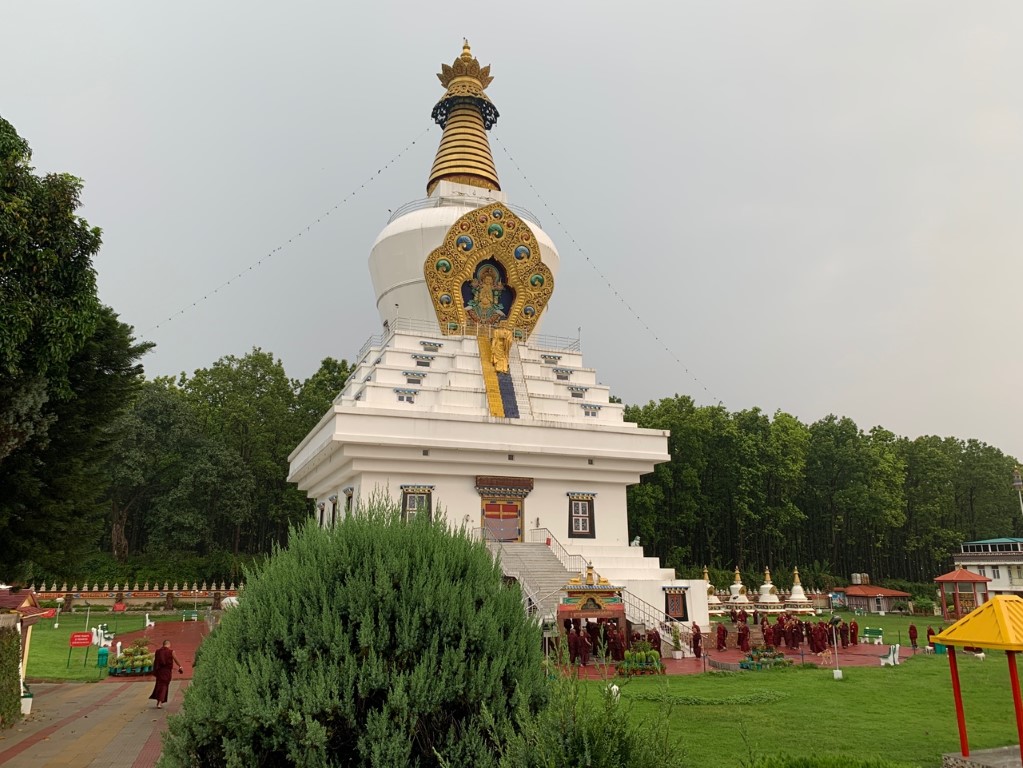
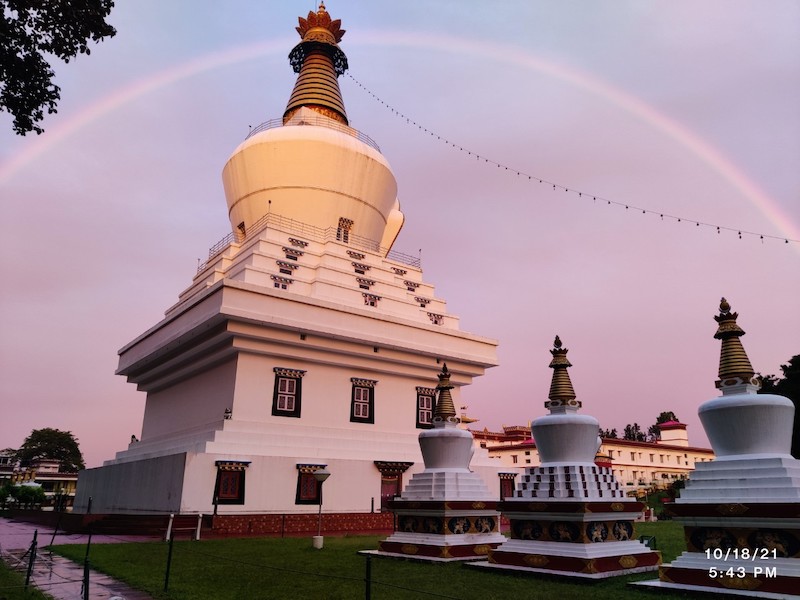
On the several floors inside the stupa are shrine rooms with elaborate murals executed in the finest tradition of Tibetan Buddhist art. Sacred relics have also been placed in the stupa.
The facade of the stupa is decorated with a beautifully painted mural of Maitreya, the future Buddha. Maitreya, it is said, will be reborn in a period of decline to renew the doctrine of the founder of Buddhism, the Buddha Shakyamuni. Maitreya is believed to be a bodhisattva, one who refuses entry into nirvana, a transcendent state free from suffering, out of a compassionate desire to help others. At present, he is believed to reside in Tushita Heaven, where he awaits his rebirth. Descending the steps is the present Buddha, Buddha Shakyamuni.
Other shrine rooms within the stupa include the Shakyamuni Buddha shrine room, the Padmasambhava shrine room depicting the eight manifestations and twenty-five disciples of Guru Padmasambhava, and the Four Immeasurables shrine room (Mindrolling Lineage shrine room) with statues of all the Trichens and Khenchens throughout the history of Mindrolling up to the present day.
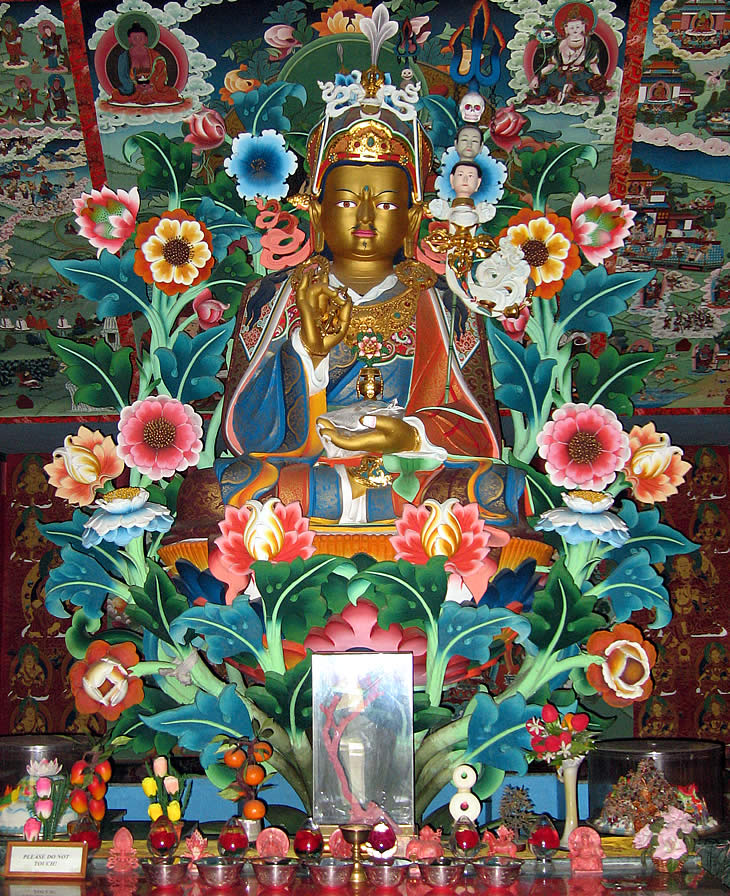
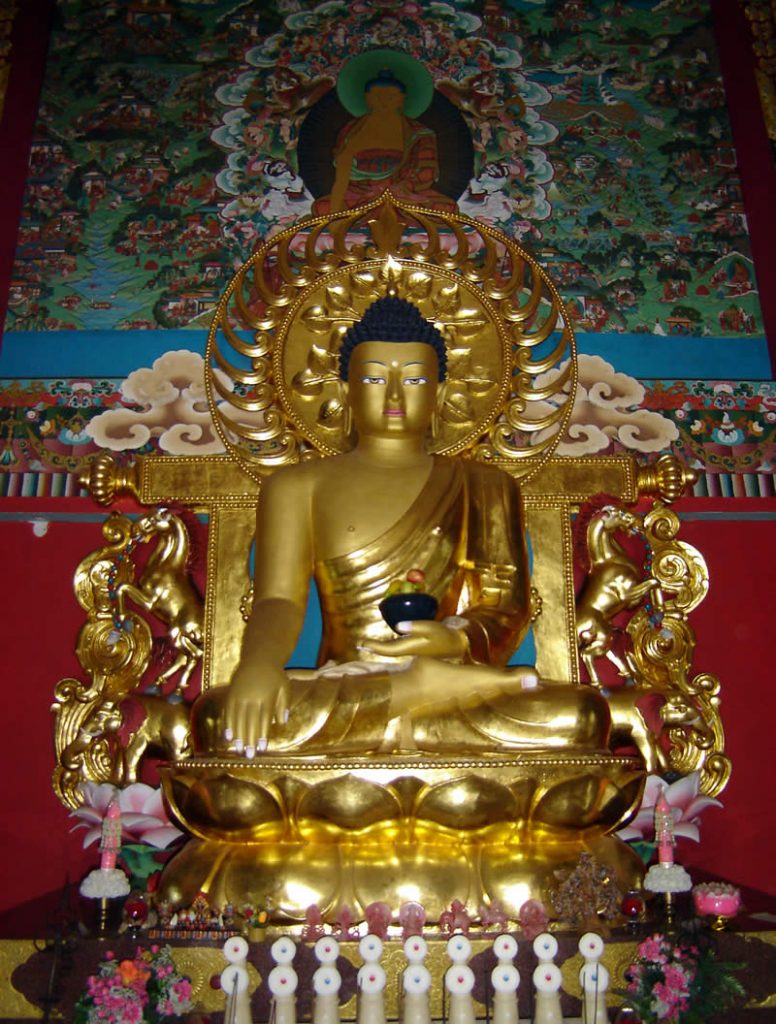
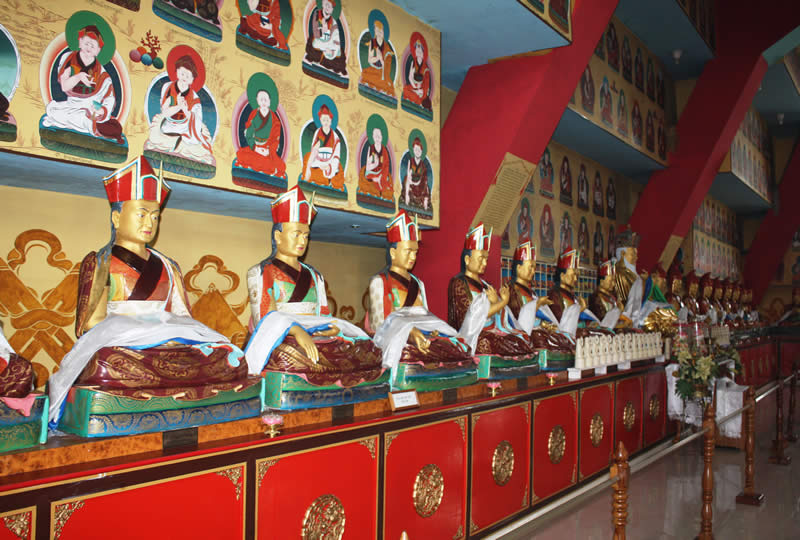
The stupa’s ground level shrine-room is dedicated to Padmasambhava. The exquisite murals in it depict the life-story of Padmasambhava in accordance with the terma of Ogyen Lingpa, Kathang Sheldrakma (the Crystal Cave Chronicles) with the hundred and eight chapters. In addition to this are murals depicting the assembly of Le u DÄnma (the Seven Chapter Supplication), Barchad Lamsal (Supplication for Clearing the Obstacles to the Path), the outer, inner and secret assembly of Rigzin Thugthig (Heart-Essence of the Vidyadharas), the short depiction of the past lives of Terchen Jurme Dorje (Terdag Lingpa), the One Hundred and Eight Mahasiddhas of India, the Twenty-Five Disciples of Padmasambhava, the Hundred and Eight Great Tertöns, the Eight Great Chariots of the Practice Lineage and various dharmapalas with their retinues.
The first floor shrine-room is dedicated to our Peerless Teacher, the Buddha Shakyamuni. On the walls are painted the principal figures of the buddhas of the three times. Beginning from the right side of the principal figures, all around on the walls are painted the Jataka Stories based on the text Wish-fulfilling Tree written by the Dharma King Kshemendra. These beautiful murals are painted with great attention to detail. On the pillars are the sixteen great arhats, the seven entrusted with the teachings and the seventeen panditas of glorious Nalanda.
The second floor shrine-room, known as the Four Immeasurables or Lineage Shine Room, is dedicated
to the great lineage holders throughout the history of Mindrolling. Within it are murals and statues depicting the descendants of the dharma king Terdag Lingpa (Rigzin Jurme Dorje) the Trichens and Khenchens of Mindrolling. In addition to this are the paintings of precious lineage masters of the Pratimoksha, Bodhisattvayana and Vajrayana.
Life-Force Tree and Mandala
The vase of the stupa holds the life-force tree. It is filled with precious relics and dharanis. On the walls are painted the images of the thousand buddhas of the Good Kalpa. In it are also the statues of the field of accumulation of the Ati Zabdon Nyingpo, from the extraordinary tradition revealed by the embodiment of the collection of all qualities of the three secrets of all the victorious sugatas, Pema Garwang Jurme Dorje (Terdag Lingpa). Furthermore, it contains the four kinds of relics, numerous extraordinary dharanis and various old and sacred statues in the form of wisdom deities.
A three dimensional mandala based on Minling Vajrasattva has also been constructed. This mandala is wondrously detailed and glorious to behold. The life-force tree is in accordance with the mandala within the tradition of Drimed Namnyi.
Relics Contained in the Great Stupa
Within the stupa are relics of Buddha Kashyapa, relics from Guru Padmasambhava’s tooth offered by Nyenchen Thanglha and so forth. All acquirable sacred substances which liberate through taste such as the relics of the body of reality, relics of various nirmanakaya manifestations, relics of raiment, relics of five kinds, and so on, all with the attribute of having passed down through genuine spiritual beings, indisputably renowned as authentic, are also placed within the stupa. In addition, whatever self-arisen representations and undoubtedly wondrous sacred substances that could be acquired are placed in this stupa.
The Commemoration
A stupa is a Buddhist monument representing the Buddha’s enlightened mind. It is essentially the earliest form of the Buddha’s image built in order to commemorate the major events in his life and to mark the sacred places where these events occurred, and to house his relics as well of those of his spiritually accomplished disciples. As the receptacle of the Buddha’s enlightened mind, a stupa encapsulates a multitude of symbolic meanings that reveal his enlightened qualities. A stupa is said to bring great benefit to the land and immense blessings to anyone who beholds it.
The Stupa of Descent from Devaloka at Mindrolling commemorates Buddha’s descent from the heaven of the thirty-three Gods (Trayastrimsa) when he was forty-two years old. Here he spent the summer retreat in Tushita heaven teaching the dharma to the reincarnation of his mother, in order to repay her kindness in having borne him just before she died. He descended in the city of Sankasya, and the local inhabitants there built a stupa in this design to commemorate the event.
Construction History
After the devastating earthquake of 21st September 1999 in Taiwan, which killed thousands of people, Venerable Master Ti Ching requested Kyabje Mindrolling Trichen’s guidance regarding what to do in memory of those who lost their lives and to pacify natural disasters in his country. Kyabje Mindrolling Trichen advised Venerable Master Ti Ching to build the largest stupa possible in Taiwan.
Building such a stupa in Taiwan was not possible, so Venerable Master Ti Ching sponsored its construction here, at Og Min Ogyen Mindrolling in India. It is called the Great Stupa for World Peace — the world’s largest stupa and a magnificent example of Buddhist art and architecture.
The stupa’s foundation was laid down on the 29th of April, 2000 and construction began in earnest on the 23rd of December the same year. This ambitious project was undertaken under the leadership of His Holiness Mindrolling Trichen and expert guidance on every aspect of the stupa by His Eminence Khochhen Rinpoche. All the expenses for the stupa were provided by the Venerable Ti Ching.
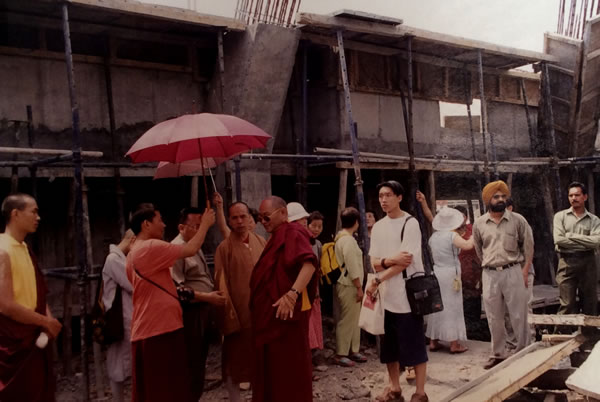
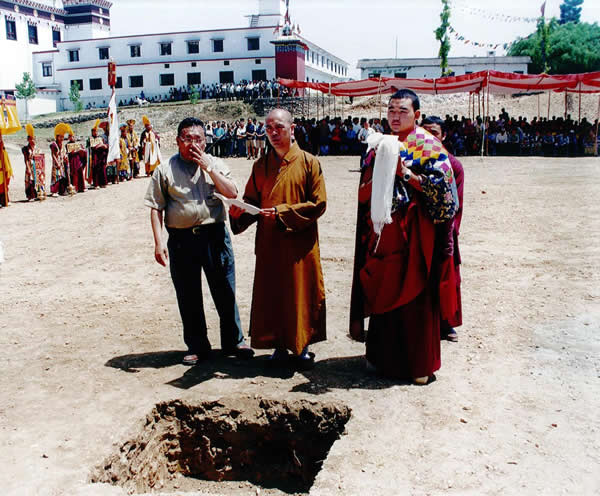
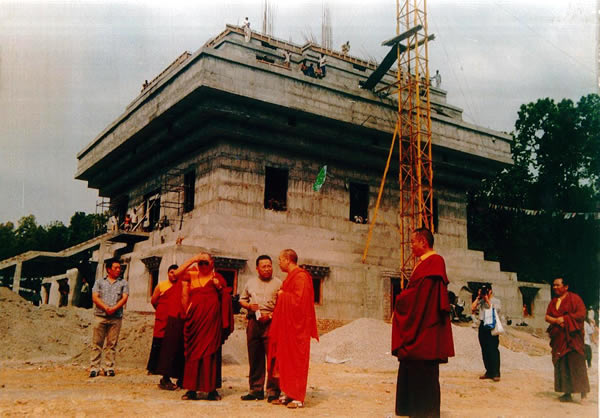
The Great Stupa of Descent from Devaloka which Liberates Upon Seeing was inaugurated on 28th of October, 2002.
The date of 28th of October, 2002 was chosen because it was the day of Buddha’s descent from Trayastrimsa. The Rinpoches of Mindrolling determined this blessed day as highly auspicious for the inauguration of the stupa. The consecration ritual and inauguration ceremony was performed in the presence of the supreme guide of peace in the world, His Holiness the 14th Dalai Lama.
Constructed to benefit all beings and dedicated to world peace, the Great Stupa was inaugurated on 28th of October, 2002
Mindrolling Commemorative Book
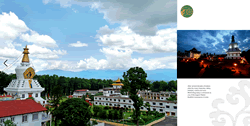
The buildings and grounds of the Mindrolling Campus can be seen on the photos published in this third section of the Mindrolling Commemorative Book (2015).
If you would like to see the Mindrolling Commemorative Book from Golden Jubilee in 2015 you can do it here.

